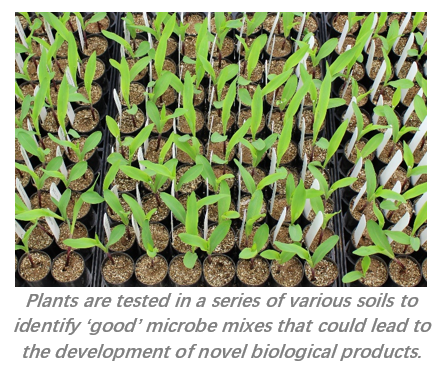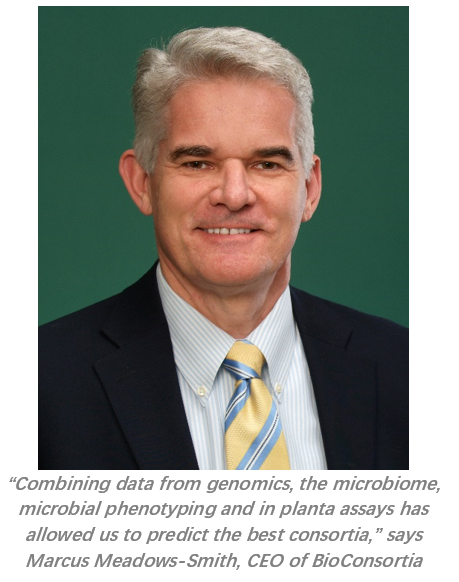Agrochemicals
Microbiome analysis and machine learning – the future of biologicals? 17th June 2019
By Sarah Harding, PhD
BioConsortia has been applying microbiome analysis and machine learning to its proprietary Advanced Microbial Selection (AMS) proc
BioConsortia has been applying microbiome analysis and machine learning to its proprietary Advanced Microbial Selection (AMS) process, identifying teams of beneficial microbes that are offering highly effective leads for potential novel biopesticides and biostimulants.
BioConsortia has quickly made a name for itself in the field of biostimulants, with its proprietary Advanced Microbial Selection (AMS) technology that uses plant breeding style techniques to evolve the microbiome over several generations of plants, and ‘big’ microbiome data to help identify teams of microbes in superior performing plants. To date, this work has been performed on behalf of different seed, agrochemical or speciality fertilizer companies seeking to develop biological products. Since establishing the global Headquarters in the USA in 2014, BioConsortia has raised around $45 million from Khosla Ventures and Otter Capital, and is currently spending about $10 million a year on its own R&D.
Focussed around the company’s patented AMS technology, a lot of investment has been targeted at the implementation of microbiome analysis, computational biology and machine learning. Artificial intelligence (AI) is receiving a lot of attention in the pharma industry – cited by Forbes as one of the top healthcare predictions for 2019, the long-anticipated era of AI in healthcare is revolutionizing drug development. These developments are mirrored in the biopesticides sector, as explained by Marcus Meadows-Smith, CEO of BioConsortia.

“A lot of the technologies we are using were developed in the pharma sector,” he says. “As tools like genome sequencing and microbiome analysis have become more mainstream in pharma, they have become more affordable and can now be applied to research in other sectors.”
The approach is based on the sequential planting of seedlings in various soils. When considering biostimulants, plants that look the healthiest are selected and the soil mixes in which they were grown are carried forward to the next stage. Ultimately, after several series, the company could have an optimal microbiome mix for plant health, growth and yield. This is the technology, applied to biostimulation and fertilizer use efficiency, upon which BioConsortia built its success, but it is now being expanded to look at biopesticides, in which a similar sequential approach is used, but using diseased seedlings that either die or resist the disease. The goal is to obtain a microbiome mix that confers protection to the growing plant.
“In fact, the results in biopesticide tests are even more clear cut,” says Meadows-Smith. “While the detection of plants growing ‘best’ in various soils can be quite subjective, the effect of the microbiome on disease resistance – whether the plant is diseased or healthy – can be much more apparent.”
However, the company’s most exciting breakthrough has come with new tools such as next generation sequencing, digital imaging and machine learning. Rather than laboriously extracting and identifying each microbe species and groups of species (consortia) for final screening, its scientists are using next generation sequencing to identify the range of microbes present in each soil sample of interest. Having detected thousands of species in each sample, machine learning is used to select those present in the rhizosphere of healthy plants (plants naturally ‘acquire’ useful microbes into their rhizospheres and support them in a symbiotic manner) but not in the soil at large. This enables rapid identification of organisms that are associated with the plants.
It doesn’t end there. After identifying associated microbes, AI can quickly identify those species or consortia that are associated with healthy, vibrant plants rather than those that do not grow well, or do not develop disease resistance.

BioConsortia’s AMS technology reduces the amount of time and money in the discovery of new microbial products by approximately two thirds, as the laboratory work of selecting, identifying and testing potentially hundreds of organisms from each soil sample is performed simply and quickly by the comparison (by computer software) of genome sequencing charts and data.
“Machine learning has been able to detect differences in microbe populations between healthy and unhealthy plants that we might not have spotted if we were doing this with basic analytic methods, and it’s given some excellent leads,” says Meadows-Smith. “Genomic analysis has also provided insight into microbial potential, by grouping genes into those with potential for nutrient acquisition, root colonization, bioactive metabolites, abiotic stress resistance, plant growth promotion, or pathogenicity. Combining data from genomics, the microbiome, microbial phenotyping and in planta assays has allowed us to predict the best consortia.”
This work has already paid off with leads for two novel biofungicides, which are undergoing assessment for EPA registration in the US, and several new biostimulants that are pending state registrations. These products have shown superior performance in field trials compared with current market-leading biologicals. The advanced technology to develop these products – combining biological, chemical and computer sciences – offers superior efficacy and increased consistency.
It seems fairly safe to conclude that this could very well be the future of biologicals.
Contact:
BioConsortia, 1940 Research Park Drive, Davis, CA 95618, USA
E: mmeadowssmith@bioconsortia.com
https://bioconsortia.com
E: mmeadowssmith@bioconsortia.com
https://bioconsortia.com



